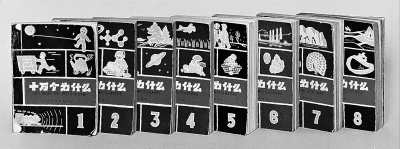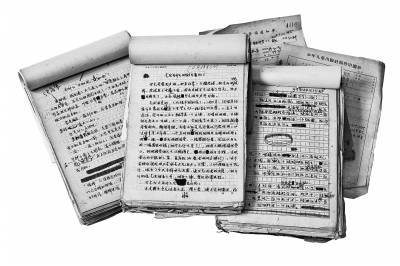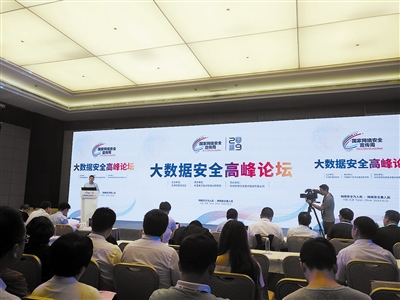[Guangming Shuhua]
In 70 years, I fell in love with science from popular science
-70th anniversary of the publication of new China science popularization.
Author: Yan Shi (deputy director of China Institute of Popular Science and former editor-in-chief of Popular Science Publishing House)
editorial comment/note
The 70-year history of the founding of New China contains a reading history of Chinese people. After 70 years, books in China have changed from "book shortage" to "book sea", and the type on paper records, leads and interacts with the times. In the book, there is also a history of ideological and cultural development. We inherit the tradition of literature and art and explore the possibility of science and technology. We climb the peak of our thoughts and sow the seeds for the education of the next generation. After 70 years, classic reading, theme reading, popular science reading, children’s reading … all kinds of books are increasingly rich and blooming, reflecting that the reading needs of Chinese people are becoming full and diverse. This issue of "Bright Reading" invites two experts to write two aspects of the 70-year reading history: popular science books and periodicals, with a view to reviewing history and looking forward to the future.

The first edition of "100,000 Why" information pictures
The history of popular science is as long as that of science and technology. Science in modern sense was first enlightened during the Renaissance in Europe, and was greatly promoted after the 17th century. The creation and publication of popular science emerged with the leap-forward development of science. The popular science works of a large number of representative writers such as Galileo, Buffon, Huxley, Fabres and Darwin have been popular for hundreds of years. At the same time, printing technology has greatly promoted the development and dissemination of science and technology and played a decisive role in promoting the industrial revolution.
Popular science publishing has always been a barometer of popular science and an important part of national soft power of science and technology. Popular science is a bridge between science and technology and social life. While imparting knowledge to readers and making them fall in love with science, it also edifies readers with scientific thoughts, scientific spirit, scientific attitude and scientific style. Since the founding of New China 70 years ago, the older generation of scientific and technological workers, popular science writers and colleagues in the field of popular science publishing have presented hundreds of millions of readers with their hard work, which has laid a solid foundation for the development of popular science and left valuable spiritual wealth.

Manuscripts written by scientists such as Li Siguang and Zhu Kezhen for 100,000 Why.
First, popular science work as a basic national policy
In September, 1949, the first plenary session of China People’s Political Consultative Conference was held, and the meeting discussed the "Common Program" with the function of interim constitution. Zhu Kezhen, a famous meteorologist and educator, and other scientists took the lead in putting the popularization of scientific knowledge into the Common Program, and made it clear that "efforts should be made to develop natural science to serve the construction of industry, agriculture and national defense. Reward scientific discoveries and inventions and popularize scientific knowledge. " Taking science popularization as a basic national policy reflects the importance attached by the Party and the state to science and science popularization, and opens a new chapter in the cause of science popularization in new China. On November 1st, 1949, China Academy of Sciences and Science Popularization Bureau of the Ministry of Culture were established respectively by the State Council of the Central People’s Government. Natural scientists, engineers, agricultural workers, medical workers, teachers and young students were widely mobilized to make popular science work a mass work. The Science Popularization Newsletter and other publications were published by the Bureau of Popular Science, covering all aspects of popular science work, which became the main channel for the public to understand popular science work at that time, so as to promote the continuous development of the national popular science movement.
In August 1950, the "All-China Association for Popularization of Science and Technology" was formally established, and then a large number of popular science books were edited and published, and speeches of scientific lectures and popular science charts were issued. Another important task of the Association is to promote the translation of a large number of popular science books in the Soviet Union, such as the Soviet Popular Science Series by the Commercial Press, the Soviet Youth Science Series by China Youth Publishing House, the Science Translation Series by Science Publishing House and the Soviet Encyclopedia series selected and translated by Higher Education Publishing House. China has also created many excellent popular science works, and a number of famous artists such as Gao Shiqi, Jia Zuzhang, Dong Chuncai and Gu Junzheng personally participated in the creation of popular science books. There are many first-class great scientists who write popular science, such as Liang Xi, Li Siguang, Zhu Kezhen, Mao Yisheng, Yan Jici, Lin Qiaozhi, Hua Luogeng, Qian Xuesen and Qian Sanqiang … Their works guide generations of young people to the forefront of science.
In July 1956, under the advocacy of all walks of life, the Science Popularization Press was formally established, and a large number of popular science books were published in response to the production and life needs of the masses. For example, Professor Zhao Xuetian of Huazhong Institute of Technology, in order to solve the problem that a large number of new workers couldn’t read the drawings at that time, went deep into the factory to understand the demand, and then wrote the book "Mechanical Workers’ Quick Drawing" in an easy-to-understand creative way, which was reprinted 19 times in a row. By 1980, the book had been issued in 16 million copies, which played a huge role in the industrialization of new China.
The wind of "Great Leap Forward" has also swept into the publishing position, and grandiose slogans such as "publishing a book is like publishing a newspaper" and "publishing a book in 48 hours" have been put forward. Although the number of books published has increased, some so-called inventions that have not been tested by practice and scientifically demonstrated have been edited and published as science, and some books have died when they were published, such as "Series of Experience in Indigenous Smelting" published by Jiangsu People’s Publishing House and "Experience of Workers and Peasants for Leaping Forward" published by Science Popularization Publishing House.
After 1961, with the improvement of the national economy, popular science publishing also showed a certain recovery, and a number of high-quality knowledge popular science series were published, and popular science creation came to a climax again. Representative works include: Knowledge Series advocated by Hu Yuzhi, a writer and publisher, and written by famous scientists such as Zhu Kezhen; Mathematics Series compiled by mathematician Hua Luogeng and published by People’s Education Publishing House; Natural Science Series edited by scientist Mao Yisheng and published by Beijing People’s Publishing House; Scientists Talk about the 21st Century written by Li Siguang and other scientists; The Secret of Snake Island written by Wu Law; The Missing Brother written by Ye Zhishan. These books have been widely welcomed by readers, including young readers.
The series "100,000 Why" has created a miracle in the history of popular science publishing in China. The first edition of "100,000 Why" was published by Shanghai People’s Publishing House in 1961-1962, with a total of 8 volumes, including physics, chemistry, astronomy, meteorology, agriculture, physiology and health, geology and minerals, animals and mathematics, with a total of 1,484 "Why" and a total of 1.05 million words. The second edition was published by Shanghai Children’s Publishing House in 1964-1965. Based on the first edition, the subject classification is more reasonable. According to the subject category, it is divided into 14 volumes, each with about 150~200 "why", with a total of 2480 questions. As soon as The Hundred Thousand Why was published, it was widely welcomed by the society. By April 1964 alone, 5.84 million copies (730,000 sets) had been published, which influenced the formation of a generation of young people’s scientific outlook in China, stimulated their love for science, and became a much-told story in the history of children’s popular science publishing in new China.
Second, popular science publishing ushered in spring
On March 18th, 1978, the National Science Conference was held. At the conference, Comrade Deng Xiaoping put forward some important conclusions, such as that science and technology are productive forces, intellectuals are part of the working class, and the key to the four modernizations is the modernization of science and technology. In the spring of science, the enthusiasm and creativity of the majority of scientific and technological workers have been fully released, and remarkable results have been achieved in promoting the publication of popular science. In April 1978, the State Council approved the official resumption of the National Association for Science and Technology, which laid a strong organizational guarantee for the development of popular science work.
In 1978, China Association for Science and Technology held a national symposium on popular science creation in Shanghai. A group of famous scientists including Hua Luogeng, Mao Yisheng and Gao Shiqi attended the symposium and initiated the establishment of China Association for Popular Science Creation. Since 1979, a number of popular science organizations, such as China Popular Science Writers Association (later renamed China Popular Science Writers Association), have been established and actively carried out popular science work in their respective fields. Science associations, societies and scientific and technological workers at all levels actively carry out popular science creation. According to rough statistics, from 1979 to 1988, more than 20,000 popular science books were published nationwide.
In October 1980, "China Institute of Popular Science Creation" (later renamed China Institute of Popular Science) was established, with Gao Shiqi, a famous popular science writer, as honorary director, systematically and deeply summarizing the practical experience of popular science creation in China. In April, 1982, the Institute of Popular Science held the "Conference on Popular Science Creation and Research Plan" in Beidaihe. At the meeting, it was decided to compile a set of "Selected Works of Popular Science", which was completed successively in 1993, with a total of 10 books.
Around the 1990s, influenced by various social trends of thought, the creation and publication of popular science received a cold reception after 10 years of prosperity, and the position of popular science was shrinking day by day, almost becoming a forgotten corner. In the meantime, pseudoscience has also risen, and some pseudoscience publications such as astrology and parapsychology, which promote all kinds of supernatural and metamaterial mysterious forces under the banner of science, have been increasing continuously. The proliferation of these superstitions and pseudoscience has caused a waste of national resources and a very bad influence on the general public.
In view of the social phenomenon of the spread of ignorance and superstition in society, on December 5, 1994, the Central Committee of the Communist Party of China and the State Council issued "Several Opinions on Strengthening the Popularization of Science and Technology". This is the first programmatic document jointly issued by the CPC Central Committee and the State Council on science popularization since the founding of New China. It is an important symbol for the Party and the government to promote the development of science popularization in the new period, which is of milestone significance. On June 20, 1995, China Association for Science and Technology invited all parties concerned to have a discussion, which was presided over by the special committee of China Association for Science and Technology to promote the natural and social sciences, and put forward the initiative of "defending the dignity of science, getting rid of ignorance and superstition, and opposing pseudoscience". He has also organized the translation of Science and Weirdness, co-authored by many famous foreign scientists, and edited popular science books such as 100 Questions on Breaking Superstition, explaining the fact that there are neither gods nor ghosts in the world with scientific reasons, exposing all kinds of deceptive schemes, and improving readers’ ability to distinguish between science and pseudoscience, superstition and natural phenomena.
At the same time, a number of domestic publishing houses have introduced and translated a number of high-level popular science publications from abroad, such as the "First Promotion Series" published by Hunan Science and Technology Publishing House, which is a masterpiece of popular science written by contemporary world-class scientists and is called "the spiritual home of science lovers". Shanghai Science and Technology Education Publishing House, on the basis of many years’ full investigation on the publishing situation of popular science at home and abroad, has carefully planned the series of "philosopher’s stone series" in response to the readers’ thirst for popular science products with strong sense of the times and deep appeal, and has become a large-scale popular science brand with far-reaching influence.
Third, the overall improvement of national scientific quality
On June 29th, 2002, People’s Republic of China (PRC) Science and Technology Popularization Law was promulgated, which is the first science popularization law in the world so far. On February 6, 2006, the State Council formulated and implemented the Outline of the Action Plan for National Scientific Literacy (2006-2010-2020), and put forward the principles, objectives, tasks and measures for the construction of Chinese citizens’ scientific literacy in the next 15 years. It is clear that improving citizens’ scientific quality is a major strategic task of the country; It sets the tasks and objectives of China citizens’ scientific quality construction in the short-term, medium-term and long-term stages. This means that, as a long-term task, the construction of scientific quality of the whole people will benefit the whole country.
Known as the "cross-century popular science publishing project", the "Academician Popular Science Book Department" is a large-scale popular science series jointly planned by China Academy of Sciences, China Academy of Engineering and Science Times, and jointly published by Tsinghua University Press and Jinan University Press. About 176 academicians of the two academies participated in the writing. The topic selection of book department is the frontier of world science and the hot issue of China’s economic and social development, such as 100 scientific problems in the 21st century, industry trend in the 21st century, magical surface engineering, flying metal-light metal and so on.
In order to cooperate with the national action plan for national scientific literacy, Science Popularization Publishing House, with the strong support of China Association for Science and Technology, started to plan the large-scale popular science topic selection of "Outline Book Series of the Action Plan for National Scientific Literacy" in 2006. Combining the introduction of excellent foreign popular science works with the development of excellent original works, it has successively developed dozens of sets of high-quality popular science books, and equipped a batch of high-quality popular science resources for libraries and farmer’s bookstores at all levels. The Chinese Association of Popular Science Writers organized and planned major selected topics such as "China Contemporary Popular Science Boutique Book Series", which greatly improved the publishing level of original popular science books in China. According to a survey conducted in 2015, there are about 200 publishing houses publishing popular science books every year in China, and the average number of new books published has exceeded 10,000. A number of important awards such as the National Science and Technology Progress Award include popular science categories.
On May 30, 2016, General Secretary of the Supreme Leader delivered an important speech at the National Science and Technology Innovation Conference, the Academician Conference of the Chinese Academy of Sciences and the Ninth National Congress of China Association for Science and Technology. It is emphasized that scientific and technological innovation and scientific popularization are the two wings to realize innovation and development, and scientific popularization should be placed in the same important position as scientific and technological innovation. It gives a brand-new orientation and requirements for popular science work in China in the new era. Facing the rapidly changing international environment, popular science work has long been not limited to the popularization of general scientific and technological knowledge, but more reflected in the overall improvement of national scientific quality. Without the general improvement of the scientific quality of the whole people, it will be difficult to establish a grand army of high-quality innovation and realize the rapid transformation of scientific and technological achievements.
In recent years, with the great attention and investment of the state, the scientific quality level of Chinese citizens has entered a stage of rapid improvement. Previous national surveys conducted by China Institute of Popular Science show that the proportion of citizens with scientific literacy in China has increased from 3.27% in 2010 to 6.20% in 2015 and further to 8.47% in 2018. Faced with the rapid development of science and technology and the huge demand of the general public for high-quality popular science resources, the traditional popular science model can no longer adapt to the changes of the new era. Popular science publishing needs to better connect with the international community, adapt to the development law of mobile reading, online reading and audio reading, and promote the deep integration and transformation of the industry. At the same time, it is necessary to strengthen the theoretical research and practical exploration of popular science creation, because no matter how the times develop, "content is king" is always the first meaning of popular science publishing.
Guangming Daily (October 4, 2019, 08 edition)

























































